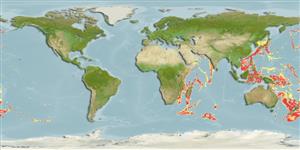>
Ophidiiformes (Cusk eels) >
Ophidiidae (Cusk-eels) > Neobythitinae
Etymology: Mastigopterus: Greek, mastax, -agos = bite + Greek, pteron = wing, fin (Ref. 45335).
More on authors: Smith & Radcliffe.
Environment: milieu / climate zone / depth range / distribution range
Ökologie
seewasser bathydemersal; tiefenbereich 394 - 2365 m (Ref. 43943). Deep-water
Indo-West Pacific: Madagascar, the East and South China seas and Papua New Guinea.
Size / Gewicht / Alter
Maturity: Lm ? range ? - ? cm
Max length : 53.5 cm SL Männchen/unbestimmt; (Ref. 43943)
Head large; mouth subterminal. Eye diameter less than snout length. Opercular spine weak, broad, and flattened. Prominent cephalic sensory pores below eyes and on rear margin of preoperculum. Median basibranchial tooth patches 2. Vomer with V-shaped tooth patch. Anterior gill arch with 10-12 long rakers. Pectoral fins 12-15 rays, the longest about 1/2 or more in SL. Pelvic fins with 2 joined rays in each. Caudal fin rays 6. Branchiostegal rays 8. Precaudal vertebrae 15-16. Cycloid scales small, deciduous, covering head, body, and bases of dorsal, anal, and pectoral fins. Lateral line indistinct (Ref. 43943).
A rare species inhabiting the deep-sea floor in the tropical to temperate waters (Ref. 43943). Reproductive strategy possibly similar to other members of this family featuring oviparity, with oval pelagic eggs floating in a gelatinous mass (Ref. 205).
Life cycle and mating behavior
Geschlechtsreife | Fortpflanzung | Ablaichen | Eier | Fecundity | Larven
Nielsen, J.G., D.M. Cohen, D.F. Markle and C.R. Robins, 1999. Ophidiiform fishes of the world (Order Ophidiiformes). An annotated and illustrated catalogue of pearlfishes, cusk-eels, brotulas and other ophidiiform fishes known to date. FAO Fish. Synop. 125(18):178p. Rome: FAO. (Ref. 34024)
IUCN Rote Liste Status (Ref. 130435)
Bedrohung für Menschen
Harmless
Nutzung durch Menschen
Fischereien: nicht kommerziell
Mehr Information
NamenSynonymeMetabolismusRäuberÖkotoxikologieFortpflanzungGeschlechtsreifeAblaichenSpawning aggregationFecundityEierEientwicklung
ReferenzenAquakulturAquakultur ProfilZuchtlinienGenetikElectrophoresesVererbbarkeitKrankheitenVerarbeitungNutrientsMass conversion
PartnerBilderStamps, Coins Misc.LauteCiguateraGeschwindigkeitSchwimmstilKiemenoberflächeOtolithsGehirngrößeSehfähigkeit
Tools
Zusatzinformationen
Download XML
Internet Quellen
Estimates based on models
Preferred temperature (Ref.
123201): 2.6 - 7.8, mean 4.8 °C (based on 786 cells).
Phylogenetic diversity index (Ref.
82804): PD
50 = 1.0000 [Uniqueness, from 0.5 = low to 2.0 = high].
Bayesian length-weight: a=0.00380 (0.00165 - 0.00876), b=3.14 (2.93 - 3.35), in cm total length, based on LWR estimates for this (Sub)family-body shape (Ref.
93245).
Trophic level (Ref.
69278): 3.7 ±0.6 se; based on size and trophs of closest relatives
Widerstandsfähigkeit (Ref.
120179): mittel, Verdopplung der Population dauert 1,4 - 4,4 Jahre. (Preliminary K or Fecundity.).
Fishing Vulnerability (Ref.
59153): Moderate to high vulnerability (46 of 100).
